
Search Wild Foods Home Garden & Nature's Restaurant Websites:
Ramps/Wild Leeks
Ramps/Wild Leeks in the woods. (By: Fungus Guy CC BY-SA 3.0)
(NOTE: If you are not interested in growing Ramps, but just finding the plant and using it, try going to the Nature's Restaurant Online site Allium Leaves and Allium Bulbs pages.)
Allium tricoccum, known as Ramp, Ramps, Wild Leek, Wild Garlic, Wood Leek, Spring Onion
This is becoming rare in some places due to over harvesting, as it is one of the more popular wild foods. The traditional Cherokee way of harvesting them, to not damage the patch of Ramps, is to just harvest the top part of the leaves. This allows the plant to live on and produce more seeds, and leaves for next year. Just take a third off of one leaf per plant (scissors are best for this). This has a great secondary advantage: no dirt to deal with.
Is the growing of this plant compatible with Natural farming, Ecoagriculture or Eco friendly agriculture, Ecological farming, Sustainable agriculture, Agroforestry or Agro-sylviculture and Permaculture: This plant can be grown using Natural farming or no-till garden methods, and can be grown with traditional gardening methods. With this one, I recommend the no-till method - especially if you choose to grow it for the greens only.
Seeds: You can buy seeds from speciality seed stores on line, or if you are lucky, where they sell seeds locally, but I wouldn't count on that. From planting, seeds can take from 6 to 18 months to get started.
Transplanting: By far, the best way to do it, is by transplanting bulbs late in the fall, or early in the spring. I have heard you can buy bulbs sometimes, though I have never found any myself. Plant the bulbs about 6-7 cm (3 inches) deep about 10-15 cm (4-6 inches) apart. Make sure the very tip of the bulb is at the soil surface. Once all are planted, cover with about 5 cm (2 inches) of deciduous leaf mulch.
Soil & Site: Unlike some wild plants that will do fine in a range of conditions, this one is picky and you need to get every aspect right. First off, to understand the light requirements, you need to understand this plant's seasonal cycle. This is a deciduous forest plant that comes out very early in the spring before the leaves on the trees are fully out. So, early in the spring, this plant needs nearly full light, but not the full blast of direct sun. In a forest, the trees and branches create a dappled shade condition. When the leaves of the trees are out fully, the leaves of the Ramp die back. Soon after the flower comes up from the bulb. The rest of the season the dormant Ramp bulb lives in a cool, moist woods in full shade. Though you might be able to recreate those conditions, the most straightforward place to plant them is where there are deciduous trees around that create the above conditions.
The next thing you need to consider is the soil. When this plant is found in the woods, it is in well drained, loamy, moist, cool soil that gets a fresh cover of deciduous leaves as mulch each fall. Not conifer needles. You need to recreate those conditions or have them already. This plant will not tolerate the soil getting hot and dry in the summer even though the plant is dormant at this time. In the woods where it can be found, the soil stays cool and moist the summer long. The soil needs to be neutral pH.
Maintenance: Once you have an area of them established, if they are happy where they are growing, they will multiply and form a dense area of Ramps. If you are harvesting leaves only, every few years when they are very packed in where they are growing, dig some up and transplant to a new spot. If you are growing to harvest the bulbs, I'd suggest having half a dozen separated areas where they are growing - planting one each year - and when you have planted the last one, harvest the first year's planting except for a few at the 10-15 cm (4-6 inch) intervals that can be left to regenerate. With this system, you will have a perpetual Ramp garden you can harvest bulbs and leaves from every year. Don't rake up any leaves that fall on the area where these grow. If not many deciduous leaves fall where these are growing, put some on the area each fall.
Harvesting: The bulbs can be harvested most of the season, but the leaves, or the leaves and bulbs together can only be harvested in early spring - later April and early May. Once the leaves come out fully on the trees in the woods where the plant is growing, the leaves on the Ramp will begin to die off. The leaves are gone by the time the flower opens.
Using: The whole plant is edible. The leaves are good to eat either raw or cooked. The flavor is like the names would indicate - an onion, garlic & leek like taste. The flavor is strong, but not hot. Because the flavor is strong, you don't need that much, so only harvest a little.
Identification: You need to be careful identifying this plant as there are plants that are very similar looking that are quite poisonous - like Lily of the Valley (Convallaria majalis), which now is naturalized in parts of eastern North America. The gathering of this wild food creates many poisonings each year from misidentification. The Ramp leaves smell strongly of an onion/garlic scent, so to be sure, tear off a bit of leaf, crush it a little and sniff. If the odour of onion/garlic is strong, you have the right plant. However, if you are not sure, don't chance it.
The colors are a help in identifying as well. When you have the whole plant dug up in early spring, it has three colors in sections that transition from one to another. The leaves are green, the bulb is white, while the central stalk is a purple to burgundy color. The purple burgundy color goes up the central vein on the leaf from partway to most of the length of the leaf. Sometimes the color is obvious, sometimes less so. Most often, the purple burgundy color goes up into the very bottom of the full width of the leaf as well. When in the ground, you see the purple burgundy starting from the ground, then the color transition area, and the green leaf.
Description:
- USDA Plant Hardiness Zone: 5-8 (More information on hardiness zones).
- Soil pH: 6.8-7.2
- Plant Size: 20 cm (8 inches) normal height
- Duration: Perennial
- Leaf Shape: Lanceolate to Elliptical
- Leaf Phyllotaxis (Arrangement) on branch: (rosette) of basal leaves (leaves at the base)
- Leaf Size: Up to 15-20 cm (6 to 8 inches) normally, occasionally up to 40 cm (16 inches) long
- Leaf Margin: Entire (smooth edged)
- Leaf Notes: Leaf is open at the top, but near the base it is folded. Often central vein (and less noticeably the veins to the side of the central vein) are purple/burgundy colored part way up the leaf. The lowest part of the leaf is often also the same color. The rest of the leaf is a lighter green
- Flowers: June/July/August - white or yellowish white sphere of flowers on stem.
- Habitat: Sandy, moist shaded woods, often near streams, very often on inclines.
Web Resources:
- Recipe search on the web here (Google search) and here (Bing search).
- Pictures on the web here (Google images) and here (Bing images).
- Interactive USDA distribution map and plant profile here.
- The Biota of North America Program (BONAP) distribution map here. BONAP map color key here.
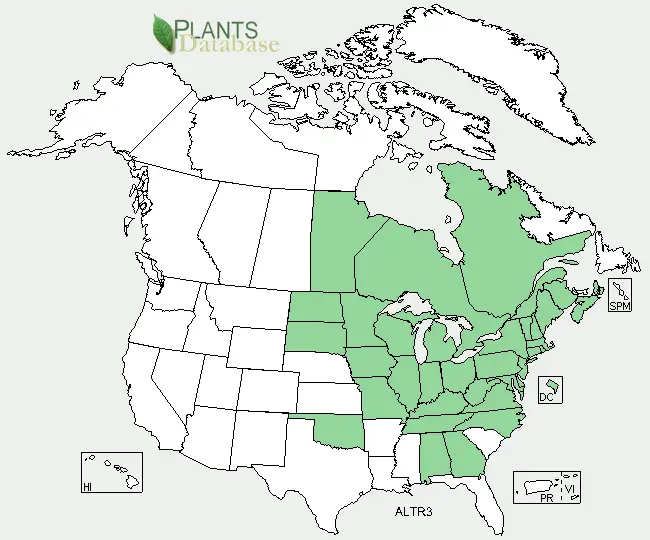
Range of Allium tricoccum, known as Ramp, Ramps, Wild Leek, Wild Garlic, Wood Leek, Spring Onion. Distribution map courtesy of U. S. Department of Agriculture (USDA Natural Resources Service) and used in accordance with their policies.
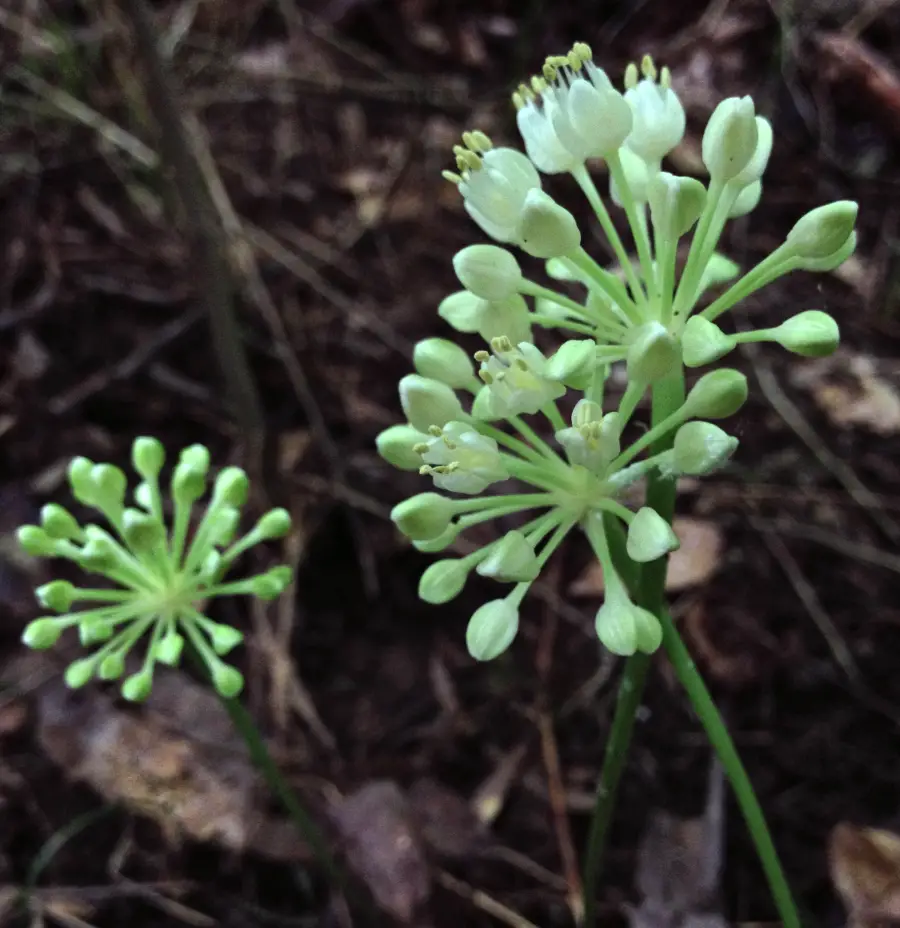
Flower in early spring. (By: Fritzflohrreynolds CC BY-SA 3.0)
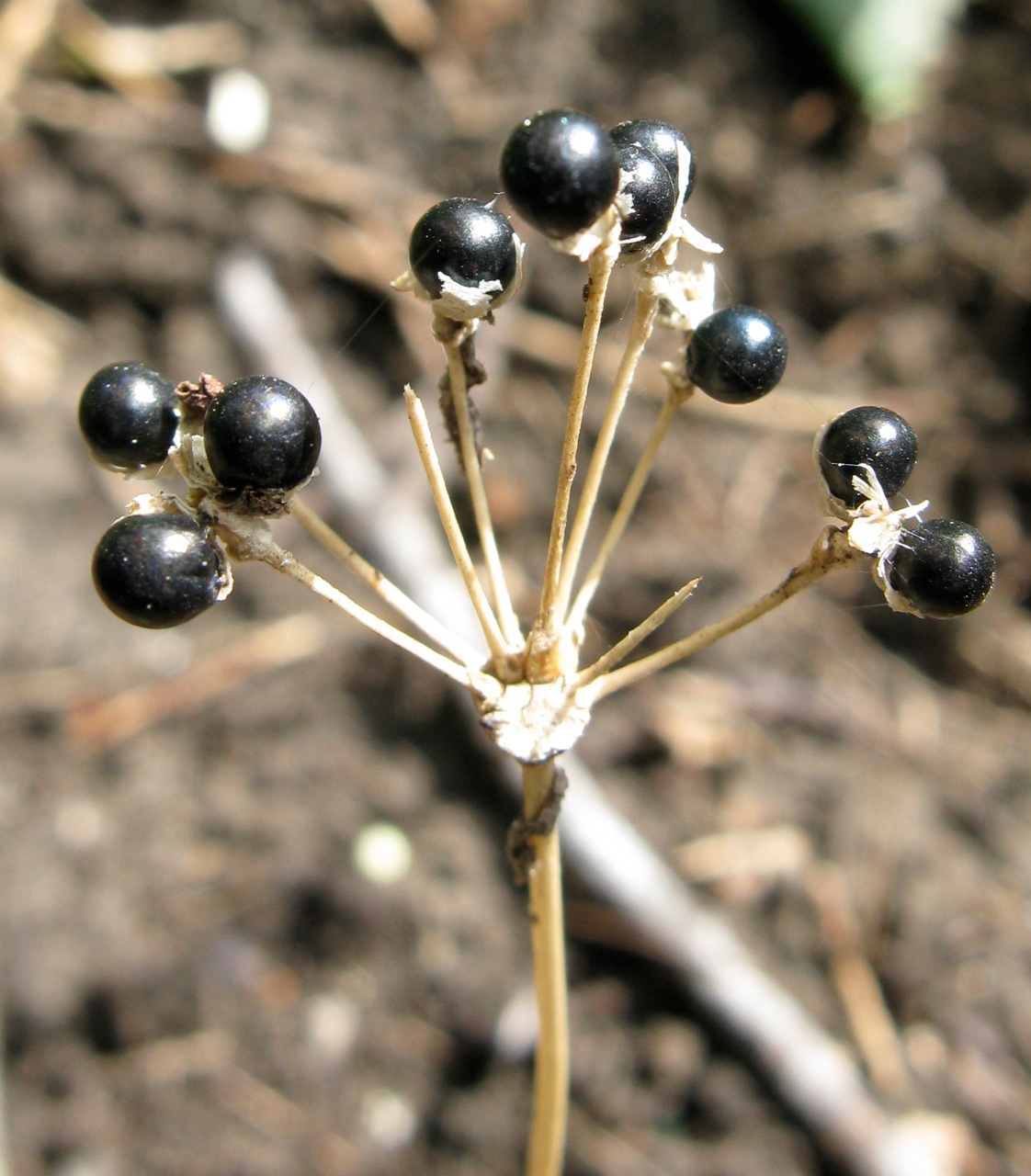
Mature seeds. (By: Nadiatalent CC BY-SA 3.0)
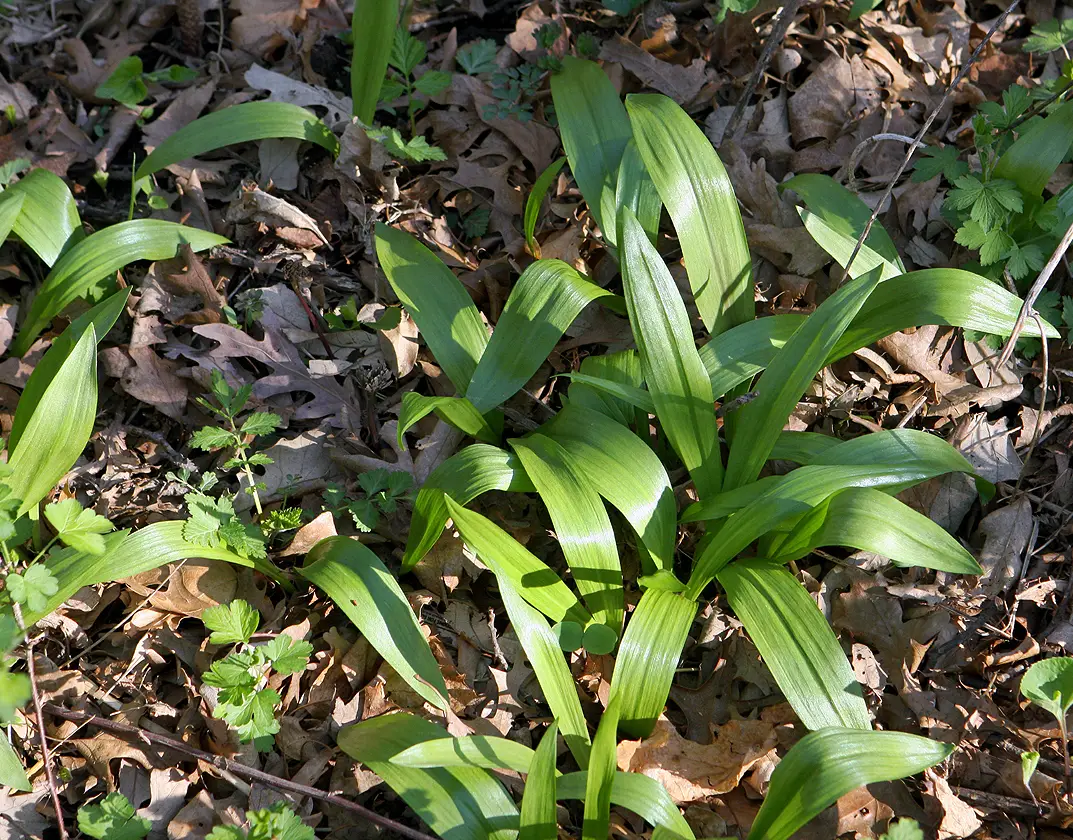
This picture shows their environment. Dappled sunlight, layer of last years tree leaves as natural mulch. (By: Hardyplants)
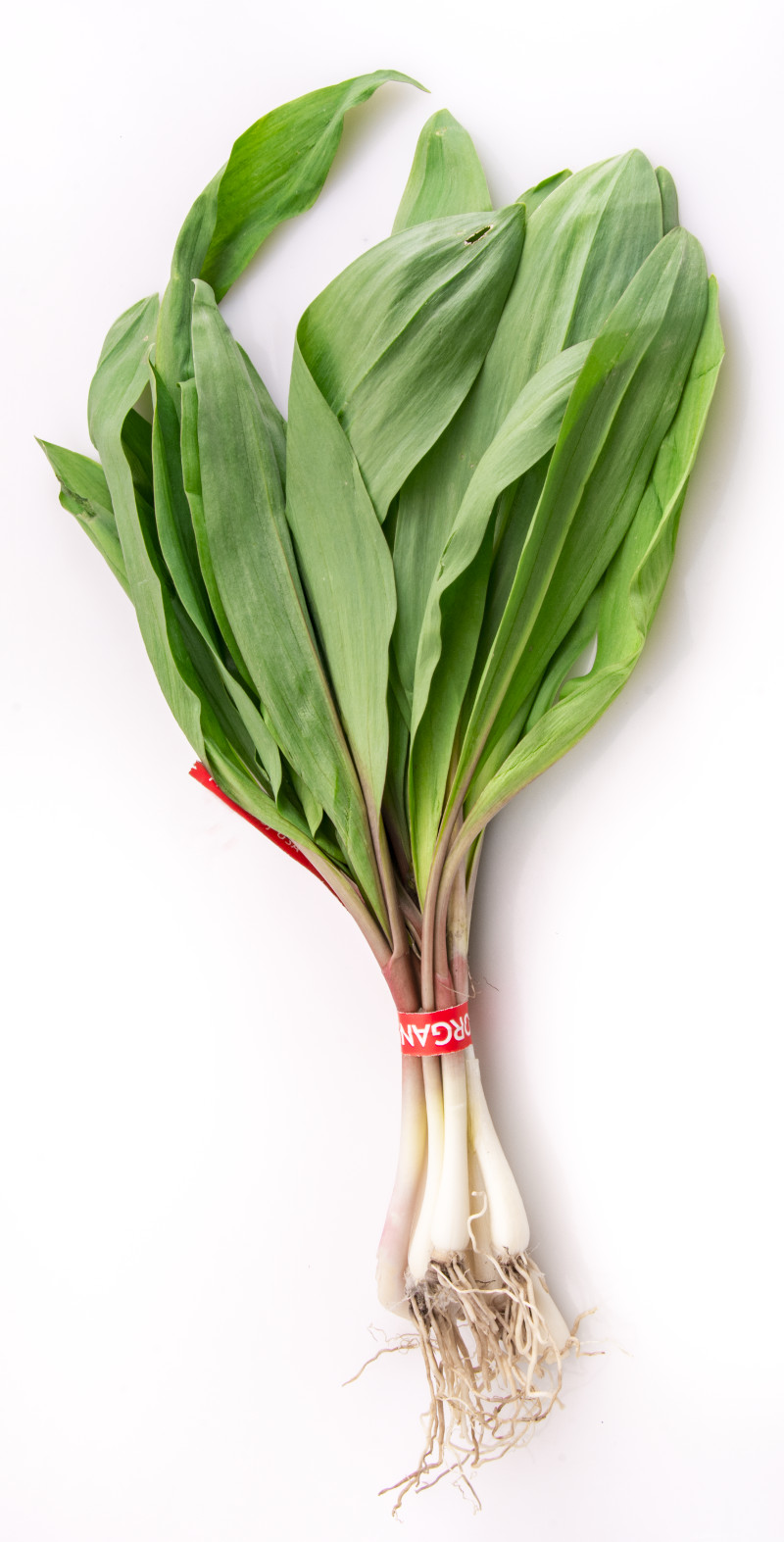
This picture of a bunch of Ramps purchased at a market shows the transition of color from the green leaf to the reddish mid-section to the white bulbs. (By: Ɱ Creative Commons CC0 1.0 Universal Public Domain Dedication)
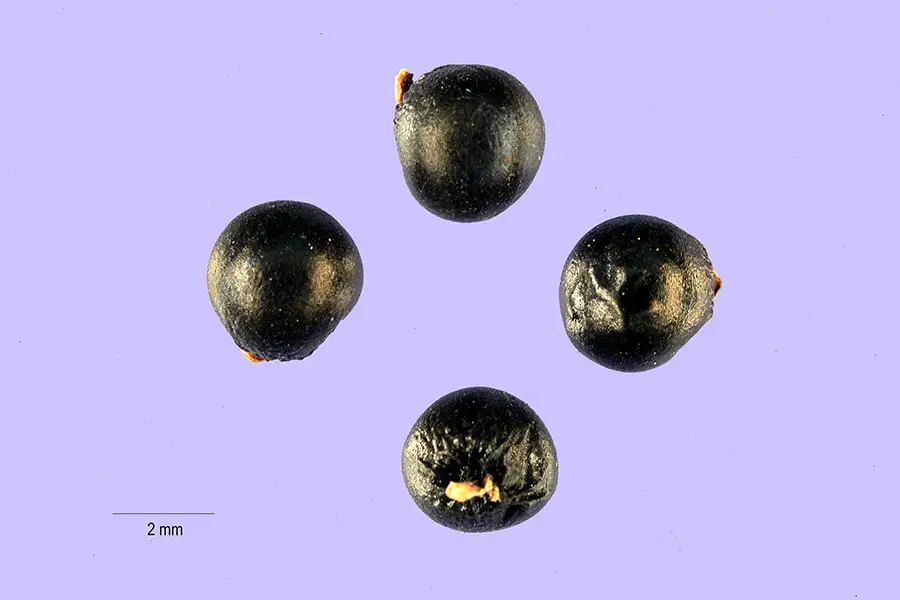
Seeds. (Tracey Slotta, hosted by the USDA-NRCS PLANTS Database)
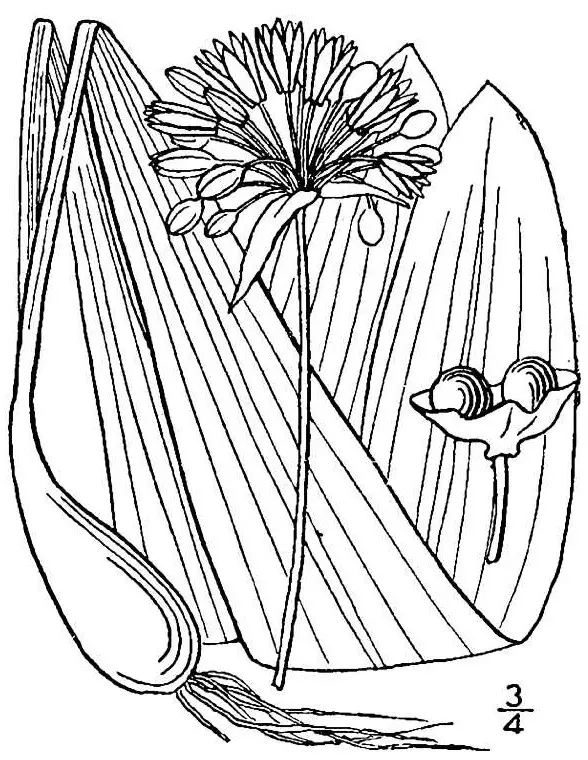
Drawing. (USDA-NRCS PLANTS Database / Britton, N.L., and A. Brown. 1913. An illustrated flora of the northern United States, Canada and the British Possessions. 3 vols. Charles Scribner's Sons, New York. Vol. 1: 497)
Search Wild Foods Home Garden & Nature's Restaurant Websites:
Share:
Why does this site have ads?
Originally the content in this site was a book that was sold through Amazon worldwide. However, I wanted the information to available to everyone free of charge, so I made this website. The ads on the site help cover the cost of maintaining the site and keeping it available.
Google + profile
